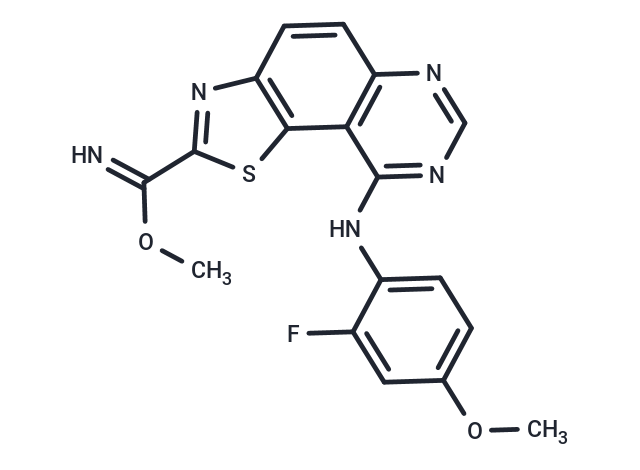Shopping Cart
- Remove All
 Your shopping cart is currently empty
Your shopping cart is currently empty

EHT 1610 (EHT 5372) is a potent inhibitor of DYRK, with an IC50 of 0.36 nM and 0.59 nM for DYRK1A and DYRK1B, respectively. EHT 1610 has an inhibitory effect on leukemia, regulating cell cycle and inducing cell apoptosis.

| Pack Size | Price | Availability | Quantity |
|---|---|---|---|
| 1 mg | $88 | In Stock | |
| 5 mg | $223 | In Stock | |
| 10 mg | $333 | In Stock | |
| 25 mg | $538 | In Stock | |
| 50 mg | $732 | In Stock | |
| 100 mg | $990 | In Stock | |
| 200 mg | $1,330 | In Stock |
| Description | EHT 1610 (EHT 5372) is a potent inhibitor of DYRK, with an IC50 of 0.36 nM and 0.59 nM for DYRK1A and DYRK1B, respectively. EHT 1610 has an inhibitory effect on leukemia, regulating cell cycle and inducing cell apoptosis. |
| Targets&IC50 | CLK2:88.8 nM, CLK1:22.8 nM, DYRK1B:0.59 nM, DYRK1B:0.28 nM, DYRK2:10.8 nM, DYRK1A:0.22 nM, DYRK1A:0.36 nM, CLK4:59 nM, GSK-3β:221 nM, β-glucuronidase:93.2 nM, GSK-3α:7.44 nM |
| In vitro | EHT 1610 triggers apoptosis in primary ALL cells that exhibit resistance to cytarabine treatment.[2] EHT 1610 demonstrates a dose-dependent induction of apoptosis in B- and T-cell lines as well as primary human pediatric cells.[2] Treatment with EHT 1610 for a duration of 72 hours leads to the inhibition of DYRK1A, resulting in the disruption of DYRK1A-mediated FOXO1 and STAT3 signaling pathways. This disruption ultimately leads to selective cell death in leukemic B cells.[3] Exposure to EHT 1610 at concentrations ranging from 2.5 to 10 μM for a period of 4-5 hours results in the inhibition of phosphorylation of FOXO1, STAT3, and cyclin D3. This inhibition leads to the regulation of late cell-cycle progression, mitochondrial ROS levels, and DNA damage, respectively.[3] |
| In vivo | In a murine model of aggressive leukemia, EHT 1610 (20 mg/kg/d; i.p.; twice a day; 3 weeks) demonstrates antileukemia activity when administered intraperitoneally.[3] |
| Alias | EHT 5372 |
| Molecular Weight | 383.4 |
| Formula | C18H14FN5O2S |
| Cas No. | 1425945-60-3 |
| Smiles | COC(=N)c1nc2ccc3ncnc(Nc4ccc(OC)cc4F)c3c2s1 |
| Relative Density. | 1.51 g/cm3 (Predicted) |
| Storage | Powder: -20°C for 3 years | In solvent: -80°C for 1 year | Shipping with blue ice. | ||||||||||||||||||||
| Solubility Information | DMSO: 4.5 mg/mL (11.7 mM), Sonication is recommended. | ||||||||||||||||||||
Solution Preparation Table | |||||||||||||||||||||
DMSO
| |||||||||||||||||||||

Copyright © 2015-2025 TargetMol Chemicals Inc. All Rights Reserved.